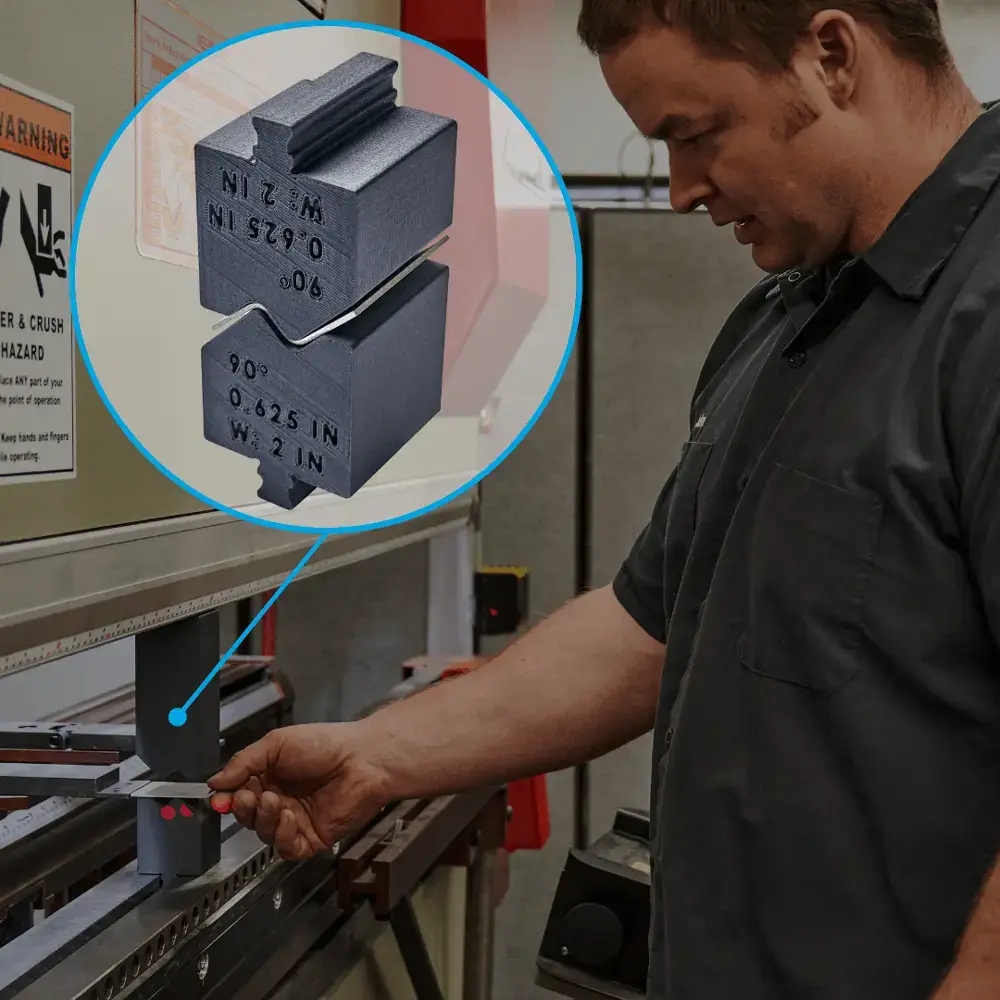The theoretical benefits of additive manufacturing are compelling, but its true value is demonstrated through real-world application.
The case of East/West Industries, a prominent supplier of aerospace components and systems, provides a powerful, data-backed example of how on-demand 3D printed tooling can solve a critical production bottleneck, delivering dramatic time and cost savings and forging a new path to manufacturing agility.
The Challenge: A Critical Forming Die Grounded by a 6-Week Lead Time
East/West Industries, a key supplier for major aerospace programs, faced a critical production stoppage that threatened to derail a key customer commitment.
The company needed to fabricate a new, custom forming die – a specialized tool used to press and shape sheet metal into a final component. This particular die was essential for producing a new cabin part for a helicopter program.
Following their standard procedure, East/West Industries approached their trusted external CNC machine shop for a quote to fabricate the tool from a block of aluminum.
The response highlighted the very bottleneck that plagues the industry: the machine shop quoted a lead time of 6 to 8 weeks to deliver the finished die.
For a project with a tight deadline, this multi-month delay was entirely unacceptable. The production line for the new helicopter component would be idled, delivery schedules would be missed, and a crucial customer relationship would be put at risk.
The company was caught in the classic tooling choke point, where the speed of their production was dictated by the slow, rigid process of conventional manufacturing.
The Solution: A 48-Hour Turnaround with FDM 3D Printing
Facing an untenable delay, the engineering team at East/West Industries pivoted to an alternative solution: in-house additive manufacturing.
Instead of waiting for the CNC vendor, they decided to leverage their own Stratasys Fortus FDM (Fused Deposition Modeling) 3D printer to produce the required forming die.
The process began with the existing CAD file for the die. Instead of being sent out for complex CAM programming, the file was loaded into the printer’s slicing software, where the toolpaths were generated automatically in a matter of minutes.
The machine was loaded with a high-strength composite material, and the print was initiated. The FDM printer then worked autonomously, building the complex geometry of the forming die layer by layer.
The total print time was just 48 hours.
Compared to the 6-week (1,008 hours) of the CNC machining quote, this represented a staggering 95% reduction in lead time.
A process that would have taken over a month and a half was completed in two days.
This dramatic acceleration not only solved the immediate production crisis but also demonstrated a fundamentally faster and more efficient workflow for creating custom tooling.
Material Deep Dive: Why FDM Nylon 12CF Was the Right Tool for the Job
The success of this rapid tooling application was critically dependent on the choice of material.
To function as a forming die, the printed part needed to withstand the significant compressive forces and friction generated during the sheet metal forming process.
For this, East/West Industries selected FDM Nylon 12CF, a carbon-fiber-reinforced polyamide 12 composite.
This material was the ideal choice for several key reasons. FDM Nylon 12CF is specifically engineered for high-stakes industrial applications, including the production of strong, stiff, and lightweight manufacturing tools and functional prototypes for the aerospace sector.
Its material properties provided the necessary performance to serve as a viable replacement for the traditionally used aluminum.
Key performance characteristics of FDM Nylon 12CF include:
- High Strength and Stiffness: With a flexural strength of up to 153 MPa and a tensile modulus (a measure of stiffness) of 9.46 GPa, the material possesses the structural integrity to resist bending and deformation under the intense pressure of the forming press.
- High Heat Resistance: The material has a heat deflection temperature (HDT) of 143°C (289°F) at 264 psi, ensuring that it maintains its shape and strength without softening under the heat generated by friction during the forming operation.
- Anisotropic Properties: Like a composite laminate, the material is anisotropic, meaning its strength is directional based on how the carbon fibers are oriented during the printing process. This allows engineers to strategically orient the part during the print setup to maximize strength and stiffness along the axes that will experience the greatest stress.
The decision to use a polymer composite to replace a metal tool is a crucial one, best understood through a direct comparison of their properties.
Comparative Analysis: FDM Nylon 12CF vs. Machined Aluminum for Custom Tooling
This analysis reveals the core of the business case. While machined aluminum is superior in absolute strength and stiffness, the FDM Nylon 12CF was more than sufficient to meet the performance requirements of this specific forming die application.
The critical insight is that a tool does not always need to be made from the strongest possible material; it needs to be made from a material that is strong enough for the job. By making an acceptable engineering trade-off on absolute strength, East/West Industries gained a massive 95% advantage in speed to production.
The Results: Validated Performance and a New Path to Production Agility
The 3D printed forming die was put into service on the factory floor and performed flawlessly. It successfully formed the required quantity of sheet metal helicopter parts to the correct specifications, validating its performance and durability in a real-world manufacturing environment.
The immediate result was the resolution of a critical production crisis. By saving over a month of waiting time, East/West Industries was able to meet its customer’s deadline, avoiding potential penalties and strengthening a vital business relationship.
However, the long-term impact was far more significant. This single success story served as a powerful proof-of-concept, demonstrating the viability of additive manufacturing as a standard workflow for tooling within the company.
It was a real-world demonstration of the strategic advantages of AM: the ability to reduce supply chain pressure, consolidate manufacturing processes, and increase overall production agility.
The experience changed the company’s approach to tooling, turning what was once a chronic bottleneck into a new source of competitive advantage. East/West Industries now possessed an in-house, on-demand capability to respond to tooling needs in days, not weeks, fundamentally changing how they approach new projects, design iterations, and unexpected production challenges.
Sign up to download the full case study pdf, or get in contact with us if you’d like to know how additive will cut your tooling time.


